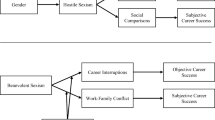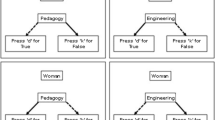Abstract
Gender segregation of careers is still prominent in the U.S. workforce. The current study was designed to investigate the role of sex-typed personality traits and gender identity in predicting emerging adults’ interests in sex-typed careers. Participants included 586 university students (185 males, 401 females). Participants reported their sex-typed personality traits (masculine and feminine traits), gender identities (gender typicality, contentment, felt pressure to conform, and intergroup bias), and interests in sex-typed careers. Results indicated both sex-typed personality traits and gender identity were important predictors of young adults’ career interests, but in varying degrees and differentially for men and women. Men’s sex-typed personality traits and gender typicality were predictive of their masculine career interests even more so when the interaction of their masculine traits and gender typicality were considered. When gender typicality and sex-typed personality traits were considered simultaneously, gender typicality was negatively related to men’s feminine career interests and gender typicality was the only significant predictor of men’s feminine career interests. For women, sex-typed personality traits and gender typicality were predictive of their sex-typed career interests. The level of pressure they felt to conform to their gender also positively predicted interest in feminine careers. The interaction of sex-typed personality traits and gender typicality did not predict women’s career interests more than when these variables were considered as main effects. Results of the multidimensional assessment of gender identity confirmed that various dimensions of gender identity played different roles in predicting career interests and gender typicality was the strongest predictor of career interests.
Similar content being viewed by others
References
Abele, A. E. (2003). The dynamics of masculine-agentic and feminine-communal traits: Findings from a prospective study. Journal of Personality and Social Psychology, 85, 768–776.
American Association of University Women Educational Foundation. (2003). Women at work. Washington, DC: Author.
Bem, S. L. (1974). The measurement of psychological androgyny. Journal of Consulting and Clinical Psychology, 42, 155–162.
Betz, N. E. (1995). Gender-related individual differences variables: New concepts, methods, and findings. In D. J. Lubinski & R. V. Dawis (Eds.), Assessing individual differences in human behavior: New concepts, methods, and findings (pp. 119–143). Palo Alto, CA: Davies-Black.
Betz, N. E., & Fitzgerald, L. F. (1987). The career psychology of women. San Diego, CA: Academic Press.
Bletz, A. M., Swanson, J. L., & Berenbaum, S. A. (2011). Gendered occupational interests: Prenatal androgen effects on psychological orientation to Things versus People. Hormones and Behavior, 60, 313–317.
Bureau of Labor Statistics. (2011a). Employed persons by detailed occupation, sex, race, and Hispanic or Latino ethnicity. Retrieved from http://www.bls.gov/cps/cpsaat11.pdf.
Bureau of Labor Statistics. (2011b). Women in the labor force: A databook (2010 edition). Retrieved from http://www.bls.gov/cps/wlf-intro-2010.htm.
Diekman, A. B., Brown, E. R., Johnston, A. M., & Clark, E. K. (2010). Seeking congruity between goals and roles: A new look at why women opt out of science, technology, engineering, and mathematics careers. Psychological Science, 21, 1051–1057.
Diekman, A., Clark, E., Johnston, A., Brown, E., & Steinberg, M. (2011). Malleability in communal goals and beliefs influences attraction to STEM careers: Evidence for a goal congruity perspective. Journal of Personality and Social Psychology, 101, 902–918.
Diekman, A. B., & Eagly, A. H. (2008). On men, women, and motivation: A role congruity account. In J. Y. Shah & W. L. Gardner (Eds.), Handbook of motivation science (pp. 434–447). New York: Guilford.
Eagly, A. H., & Karau, S. J. (2002). Role congruity theory of prejudice toward female leaders. Psychological Review, 109, 573–598.
Eccles, J. S. (1994). Understanding women’s educational and occupational choices. Psychology of Women Quarterly, 18, 585–609.
Egan, S. K., & Perry, D. G. (2001). Gender identity: A multidimensional analysis with implications for psychosocial adjustment. Developmental Psychology, 37, 451–463.
Fulcher, M. (2011). Individual differences in children’s occupational aspirations as a function of parental traditionality. Sex Roles, 64, 117–131.
Gottfredson, L. S. (1981). Circumscription and compromise: A developmental theory of occupational aspirations. Journal of Counseling Psychology, 28, 545–579.
Holland, J. L. (1959). A theory of vocational choice. Journal of Counseling Psychology, 6, 35–45.
Holland, J. L. (1997). Making vocational choices: A theory of vocational possibilities and work environments. Odessa, FL: Psychological Assessment Resources.
Huston, A. C. (1983). Sex typing. In E. M. Hetherington (Ed.), Handbook of child psychology: Socialization, personality, and social development (4th ed., Vol. 4, pp. 387–467). New York: Wiley.
Leaper, C., & Van, S. R. (2008). Masculinity ideology, covert sexism, and perceived gender typicality in relation to young men’s academic motivation and choices in college. Psychology of Men & Masculinity, 9, 139–153.
Lemkau, J. P. (1984). Men in female-dominated professions: Distinguishing personality and background features. Journal of Vocational Behavior, 24, 110–122.
Lenton, A. P., Blair, I. V., & Hastie, R. (2001). Illusions of gender: Stereotypes evoke false memories. Journal of Experimental Social Psychology, 37, 3–14.
Liben, L. S., & Bigler, R. S. (2002). The developmental course of gender differentiation: Conceptualizing, measuring, and evaluation constructs and pathways. Monographs of the Society for Research in Child Development, 67, vii–147.
Lippa, R. A. (1998). Gender-related individual differences and the structure of vocational interests: The importance of the people-things dimension. Journal of Personality and Social Psychology, 74, 996–1009.
Lippa, R. A. (2005). Gender, nature, and nurture. Mahwah, NJ: Lawrence Erlbaum Associates.
Lips, H. M. (2003). The gender pay gap: Concrete indicator of women’s progress toward equality. Analysis of Social Issues and Public Policy, 3, 87–109.
Mahalik, J. R., Perry, J. C., Coonerty-Femiano, A., Catraio, C., & Land, L. N. (2006). Examining conformity to masculinity norms as a function of RIASEC vocational interests. Journal of Career Assessment, 14, 203–213.
Martin, C. L., & Dinella, L. M. (2002). Children’s gender cognitions, the social environment, and sex differences in cognitive domains. In A. McGillicuddy-De Lisi & R. De Lisi (Eds.), Advances in applied developmental psychology (Vol. 21, pp. 207–239). Westport, CT: Ablex Publishing.
Martin, C. L., & Dinella, L. M. (2012). Congruence between gender stereotypes and activity preference in self-identified tomboys and non-tomboys. Archives of Sexual Behavior, 41, 599–610.
Martin, C. L., Eisenbud, L., & Rose, H. (1995). Children’s gender-based reasoning about toys. Child Development, 66, 1453–1471.
Martin, C. L., & Halverson, C. F. (1981). A schematic processing model of sex typing and stereotyping in children. Child Development, 54, 1119–1134.
Martin, C. L., Ruble, D. N., & Szkrybalo, J. (2002). Cognitive theories of early gender development. Psychological Bulletin, 128, 903–933.
Metzler-Brennan, E., Lewis, R. J., & Gerrard, M. (1985). Childhood antecedents of adult women’s masculinity, femininity, and career role choices. Psychology of Women Quarterly, 9, 371–382.
National Academy of Sciences. (2006). Beyond bias and barriers: Fulfilling the potential of women in academic science and engineering. Retrieved from http://www.nap.edu/catalog/11741.html.
Patterson, M. (2012). Self-perceived gender typicality, gender-typed attributes, and gender stereotype endorsement in school-aged children. Sex Roles, 67, 422–434.
Perry, D. G., & Pauletti, R. E. (2011). Gender and adolescent development. Journal of Research on Adolescence, 21, 61–74.
Rand, L. (1968). Masculinity or femininity? Differentiating career-oriented and homemaking-oriented college freshmen women. Journal of Counseling Psychology, 15, 444–450.
Ruble, D. N., & Martin, C. L. (1998). Gender development. In W. Damon & N. Eisenburg (Eds.), Handbook of child psychology: Vol. 3, Social, emotional, and personality development (5th ed., pp. 933–1016). Hoboken, NJ: Wiley.
Ruble, D. N., Martin, C. L., & Berenbaum, S. A. (2006). Gender development. In N. Eisenberg (Ed.), Handbook of child development (pp. 858–932). New York: Wiley.
Ruble, D. N., Taylor, L. J., Cyphers, L., Greulich, F. K., Lurye, L. E., & Shrout, P. E. (2007). The role of gender constancy in early gender development. Child Development, 78, 1121–1136.
Spence, J. T. (1993). Gender-related traits and gender ideology: Evidence for a multifactorial theory. Journal of Personality and Social Psychology, 64, 624–635.
Super, D. E. (1953). A theory of vocational development. American Psychologist, 8, 185–190.
Super, D. E. (1990). A life-span, life-space, approach to career development. In D. Brown & L. Brooks (Eds.), Career choice and development (pp. 167–261). San Francisco, CA: Jossey-Bass.
Tokar, D. M., & Jome, L. M. (1998). Masculinity, career choices, and vocational traditionality: Evidence for a fully mediated model. Journal of Counseling Psychology, 45, 424–435
Weisgram, E. S., & Bigler, R. S. (2006). Girls and science careers: The role of altruistic values and attitudes about scientific tasks. Journal of Applied Developmental Psychology, 27, 326–348.
Weisgram, E. S., Bigler, R. S., & Liben, L. S. (2010). Gender, values, and occupational interests among children, adolescents, and adults. Child Development, 81, 778–796.
Weisgram, E. S., Dinella, L. M., & Fulcher, M. (2011). The role of masculinity/femininity, values, and occupational value affordances in shaping young men’s and women’s occupational choices. Sex Roles., 65, 243–258.
Zheng, L., Lippa, R. A., & Zheng, Y. (2011). Sex and sexual orientation differences in personality in China. Archives of Sexual Behavior, 40, 533–541.
Acknowledgments
This study was funded, in part, by Monmouth University’s Grant in Aid of Creativity and by the Lenfest Grant. The authors would like to thank Ryan Laswell, Sara Rae, Lauren Kaniewski, and Amanda Grunwald of UWSP, and Deanna Stango, Brittney Austin, Erin Barrett, Jenna DeLozier, Lina Jaramillo, and Maria Mereos of MU for their assistance with data collection and entry and bibliographic assistance.
Author information
Authors and Affiliations
Corresponding author
Rights and permissions
About this article
Cite this article
Dinella, L.M., Fulcher, M. & Weisgram, E.S. Sex-Typed Personality Traits and Gender Identity as Predictors of Young Adults’ Career Interests. Arch Sex Behav 43, 493–504 (2014). https://doi.org/10.1007/s10508-013-0234-6
Received:
Revised:
Accepted:
Published:
Issue Date:
DOI: https://doi.org/10.1007/s10508-013-0234-6




